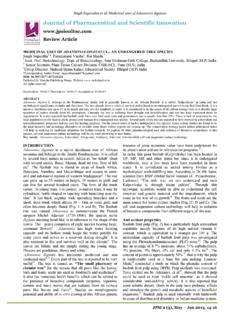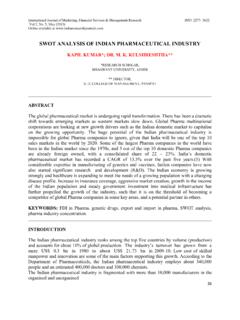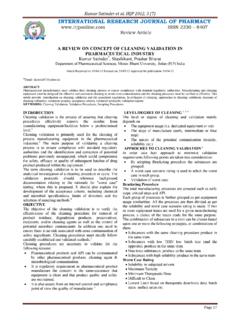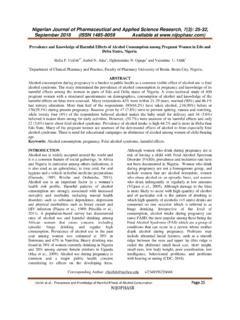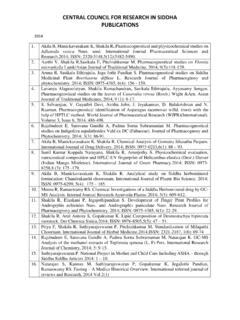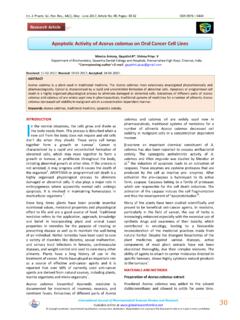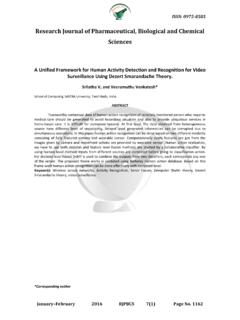Transcription of Journal of Pharmaceutical and Scientific Innovation
1 Govinda Sharma K et al: J. Pharm. Sci. Innov. 2018; 7(5) 175 Journal of Pharmaceutical and Scientific Innovation (ISSN : 2277 4572) research Article PHARMACOGNOSTIC EVALUATION OF AN INDIGENOUS AYURVEDIC POLYHERBAL FORMULATION: SUMUKTI SYRUP Govinda Sharma K 1*, Reshma Saokar 1, Suhas Kumar Shetty 2, Mundurugu Ravi 3 1 Associate Professor, Department of Rasa Shastra & Bhaishajya Kalpana, Sri Dharmasthala Manjunatheshwara College of Ayurveda & Hospital, Hassan 573201, Karnataka, India 2 Professor & Head, Department of Mano Vijnana Avum Manasa Roga, Sri Dharmasthala Manjunatheshwara College of Ayurveda & Hospital, Hassan 573201, Karnataka, India 3 research Officer, Pharmacology, Sri Dharmasthala Manjunatheshwara Center for research in Ayurveda and Allied Sciences, Udupi, Karnataka, India *Corresponding Author Email: DOI: Received on: 01/08/18 Revised on: 22/08/18 Accepted on.
2 08/09/18 ABSTRACT The present study is an effort to develop a polyherbal formulation (Sumukti Syrup) to treat alcohol dependency and its standardization. The compound is prepared with herbs that are nootropic (Medhya), immunomodulators (Rasayana), carminating (Deepana) and with hepatic stimulants (Yakrituttejaka) properties. The ingredients are Kiratatikta (Swertia chirata), Draksha (Vitis vinifera), Katuki (Picrorhiza kurroa), Bhringaraja (Eclipta alba), Mandookaparni (Centella asiatica), Guduchi (Tinospora cordifolia), Hareetaki (Terminalia chebula), Vibhitaki (Terminalia belerica), Amalaki (Emblica officinalis), Ashwagandha (Withania somnifera) and Yastimadhu (Glycyrrhiza glabra) which is prepared in Syrup form following standard protocols. The raw materials were collected, authenticated and standardized as per Department of AYUSH, Ministry of Health & Family welfare, Government of India guidelines.
3 In the present study, the physico-chemical parameters in terms of total ash, acid insoluble ash, water soluble extractive value and alcohol soluble extractive value of the raw materials are comparable with pharmacopeia standards. HPTLC photo documentation of raw materials as well as finished product provided a hint towards isolation of few constituents to the finished product. The results of total solids, total sugar, reducing sugar, non-reducing sugar, specific gravity and refractive index of study formulation can be considered as preliminary standards. Key words: Syrup, Polyherbal, Standardization, HPTLC, Sumukti INTRODUCTION Since time immemorial, plants were the natural resources for food, clothing, shelter, and medicine. Treatment of illness was carried out by using plants, animal parts, and minerals that were not part of their usual all probability trial and error methods were used by ancient scholars to distinguish useful plants, beneficial effects, combinations and processing techniques to get consistent and optimal results.
4 In due course of time, the art of converting raw drugs into medicine developed as a science. According to nativity and cultures of different geographical regions, number of formulations using single and compound raw materials was invented. All medicines, whether synthetic or of plant origin, should fulfill the basic requirements of being safe and effective2-3. Standardization of herbal medicines is the process of prescribing a set of standards or inherent characteristics, constant parameters, and definitive qualitative and quantitative values that carry an assurance of quality, efficacy, safety, and reproducibility4. It is common to have many plant ingredients in a herbal formulation. Due to the complex nature and variability of the constituents, herbal preparations are likely to have variations right from the stage of collection of raw materials.
5 In the past, due to the absence of a standard reference for identification, it was difficult to establish the quality control measures for polyherbal formulations. However, nowadays, efforts have been made so that herbal preparations comply with the consistent standards through modern analytical techniques5. Sumukti syrup is a polyherbal medication which was developed as a remedy for alcohol dependence based on traditional knowledge. It is a known fact that the alcoholism is an addiction that affects the physical, mental and social health of an individual. Number of Ayurveda formulations like Ashtangalavana, Guduchyadi yoga, Ashwagandharishta, Shreekhandasava has been proved to be effective against the symptoms of alcohol use Even though the above clinical trials have shown a promising result, the treatment protocols are not applicable much, as it requires in patient care to carry out the procedures as specified by the research outcome.
6 Further, few medications aim only at mental faculties whereas few formulations aim at hepatic damage. In some cases, the formulations are designed to curb the craving. Hence there was a need for generating a formulation with holistic approach of correcting the vitiation of the Dosha in all systems. Hence an approach towards overcoming the ill effects of alcoholism on both physical and mental faculties was thought of. With this aim, a compound formulation Sumukti syrup was designed. This compound is prepared with drugs that are nootropic (Medhya), immunomodulators (Rasayana), carminative (Deepaka) and with hepatic stimulants (Yakrituttejaka) properties. The ingredients are Kiratatikta (Swertia chirata), Govinda Sharma K et al: J. Pharm. Sci. Innov. 2018; 7(5) 176 Draksha (Vitis vinifera), Katuki (Picrorhiza kurroa), Bhringaraja (Eclipta alba), Mandookaparni (Centella asiatica), Guduchi (Tinospora cordifolia), Hareetaki (Terminalia chebula), Vibhitaki (Terminalia belerica), Amalaki (Emblica officinalis), Ashwagandha (Withania somnifera) and Yastimadhu (Glycyrrhiza glabra).
7 Among them Kiratatikta, Draksha, Katuki and Bringaraja are useful in hepatic disorders (Yakritvikara) and Guduchi are known nootropic (Medhya) drugs24-29 Hareetaki, Vibhitaki and Amalaki are selected for their ability to relieve the vitiation of body humors (Dosha).30-34 Ashwagandha and Yastimadhu are immunomodulators (Rasayana)35-38 in nature. Based on these factors the ingredients of Sumukti syrup were selected. MATERIALS AND METHODS Collection of raw drugs: The raw materials were procured from Sri Dharmasthala Manjunateshwara Ayurveda Pharmacy (SDMAP) Udupi and Teaching Pharmacy of Sri Dharmasthala Manjunateshwara College of Ayurveda (SDMCA) Hassan. Few ingredients like Sugar and Draksha were purchased from a provisional store in Hassan. The fresh drugs like Guduchi, Bhringaraja and Mandukaparni were collected from SDMCA Hassan herbal garden.
8 (Table 1) Authentication of the raw drugs: All the raw materials were tested and authenticated by Department of Dravyaguna SDMCA Hassan. The authentication was done based on morphological features, organoleptic features and with the help of standard herbarium specimen. The authentication was also done based on physico chemical parameters at Sri Dharmasthala Manjunatheshwara research Centre of Ayurveda and Allied Sciences (SDMCRAAS) Udupi. Preparation of Sumukti Syrup Preparation of decoction for Sumukti syrup: Ingredients Sl no 1 to 11 were taken in the quantity as specified. The dry drugs (Sl no 3-6 & 9 to 11) were converted to coarse powder by pounding. The wet drugs (Sl no 1,2,7& 8) were cleaned and cut into smaller pieces. 200ltr of potable water (Sl no 12) was added and kept on mild flame on a gas stove. Continuous stirring was done till it reduced to th quantity.
9 It was then filtered with a clean cloth and measured. (Table 1) Preparation of Sumukti syrup: The prepared kashaya was taken in a clean vessel. To that prescribed quantity of sugar (Sl no 13) was added and kept on mild fire. It was continuously stirred till one thread consistency was obtained. After completion of heating process sodium benzoate was added as a preservative. (Table 1) Analysis of Sumukti Syrup The pharmacognostic evaluation of raw materials for identity purity and strength as well as physico-chemical parameters of finished product including HPTLC was also done following standard protocol specified by Department of AYUSH, Ministry of Health & Family welfare, Government of India39 at SDMCRAAS Udupi. Table 1: Ingredients and proportion of Sumukti syrup Sl No Drug name Latin name Part used Proportion 1 Guduchi Tinospora cordifolia Stem 400 g 2 Bringaraja Eclipta alba Whole plant 400 g 3 Kiratatikta Swertia chirata Whole plant 800 g 4 Amalaki Emblica officinalis Fruit 400 g 5 Hareetaki Terminalia chebula Fruit 400 g 6 Vibhitaki Terminalia belerica Fruit 400 g 7 Draksha Vitis vinifera Fruit 3200 g 8 Mandukaparni Centella asiatica Whole plant 400 g 9 Ashwagandha Withania somnifera Root 400 g 10 Yashtimadhu Glycyrrhiza glabra Stem 400 g 11 Katuki Picrorhiza kurroa Root 800 g 12 Water 200 liters 12 Sugar 50kg 13 Sodium benzoate Preservative 250g OBSERVATIONS AND RESULTS Observations of Pharmaceutical and analytical study are as shown in Table 2-6.
10 Guduchi Bringaraja Kiratatikta Govinda Sharma K et al: J. Pharm. Sci. Innov. 2018; 7(5) 177 Amalaki Hareetaki Vibhitaki Ashwagandha Yashtimadhu Katuki Draksha Mandukaparni Figure 1: Raw materials of Sumukti syrup Table 2: Observation of decoction for Sumukti syrup Time Temp in 0C Observations am 30 Kashaya dravyas floating am 90 Just started to boil am 94 Boiling with bubbles pm 96 All dravyas mildly sunk, vapours increased pm 96 Boiling, colour of Kashaya brown pm 96 Smell of triphala, katuki, kiratatikta felt pm 96 Volume of water reduced, smell and colour same pm 96 Dark brown colour Kashaya with strong smell of drugs, volume nearing to 1/4th reduction pm 96 Volume reached th, boiling discontinued pm 70 52 liters of dark brown Kashaya obtained Table 3: Observation of Sumukti Syrup Time Temp in 0C Observations am 30 Sugar added am 52 Sugar partly dissolved am 62 Sugar completely dissolved pm 60 Kashaya filtered to remove physical impurities pm 42 Kashaya kept for boiling again pm 64 Syrup started to boil pm 62 Became little viscous, colour dark brown pm 64 Still more viscous, dark brown colour pm 60 One thread consistency obtained, stopped boiling am 57ltr of dark brown syrup obtained, viscous in nature Table 4.
